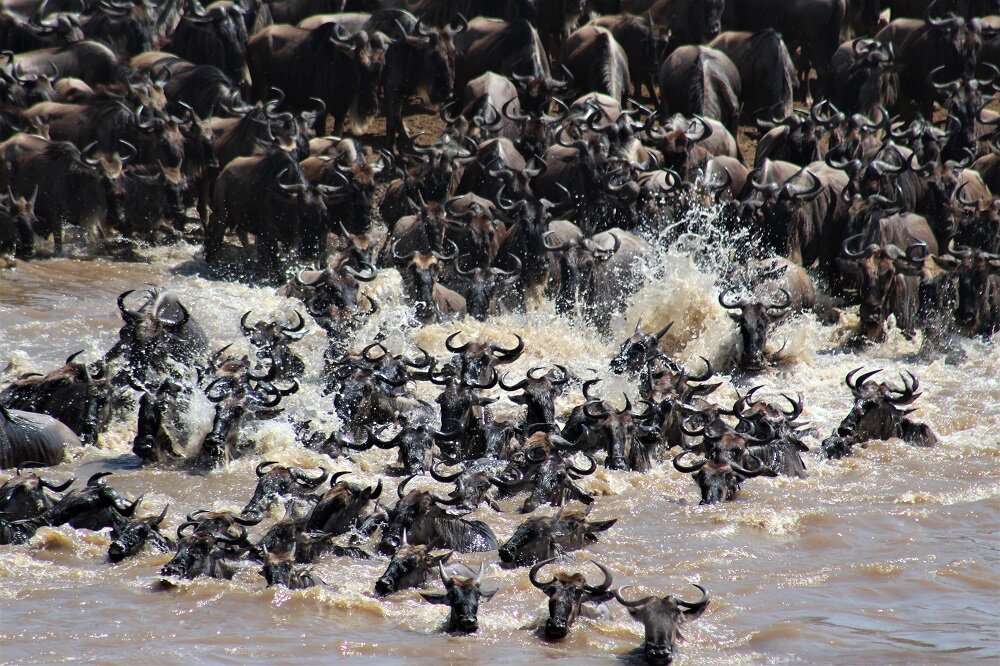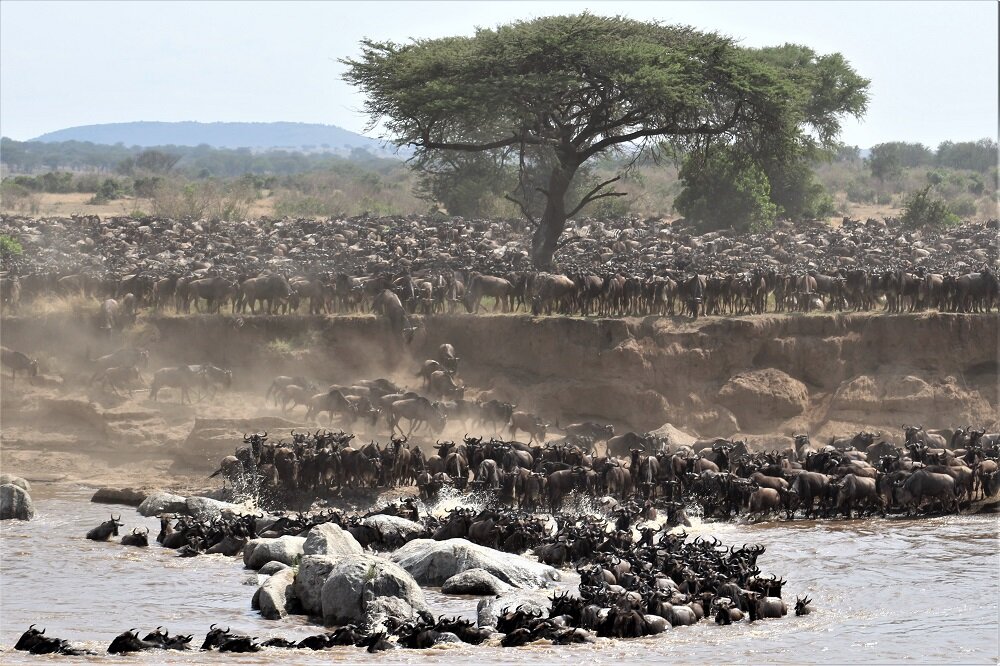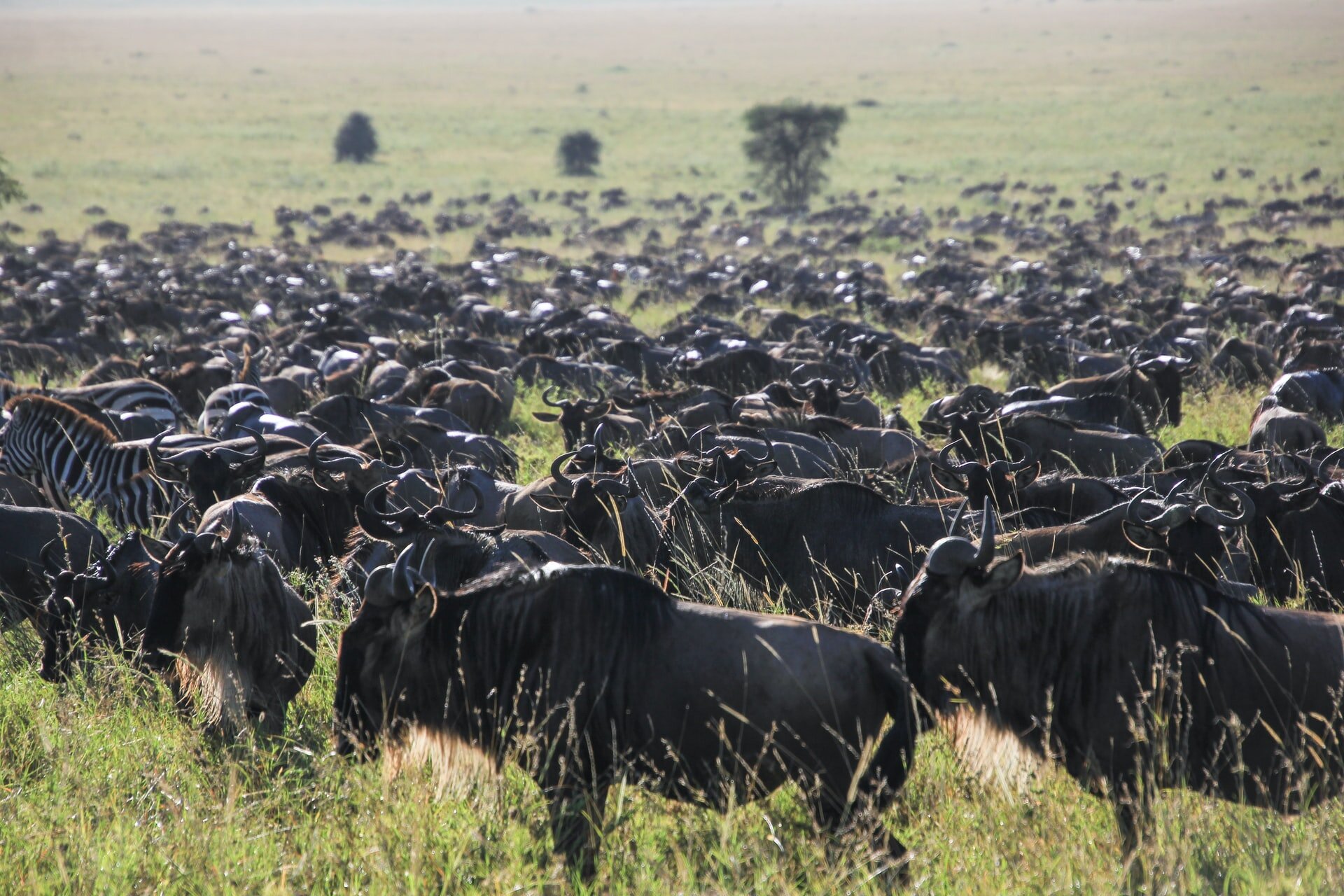10 Facts About the Great Wildebeest Migration
The Great Wildebeest Migration: 10 Facts You Might Not Know
Often simply referred to as ‘The Great Migration’, this spectacular movement of animals is remarkable both in terms of the length of the journey and the sheer numbers of animals that take part. Most of our guests who come on our tailor-made Tanzania safaris are looking to see The Great Migration during their tour – and the Serengeti never disappoints. That’s one of the best things about it from a safari’s perspective: you can hardly miss it, as we know roughly where the herds are going to be at different times of the year. Just to whet your appetite, we here at Sababu Safaris decided to put together this safari guide to the Great Wildebeest Migration, offering 10 fascinating facts you might not know. If any of these facts pique your interest and you’d like to book a safari, please feel free to get in touch.
10) About Two Million Animals Travel Across the Serengeti
The Great Migration’s claim to fame is the sheer numbers of large land mammals travelling across the Serengeti. There are roughly 1.5 million wildebeest, 200,000 zebra, and 350,000 various kinds of antelope, such as eland, Thompson’s gazelle, and impala. It’s the spectacular size of this bustling horde of large animals that makes it the world's largest terrestrial animal migration.
9) A Group Intelligence Steers the Great Migration
From the outside, the Great Migration looks utterly chaotic. The sheer numbers and movement of the individual wildebeest, zebra, and antelope can appear completely aimless. However, careful study of this behavior each year has shown that the herd, as a whole, possesses a ‘swarm intelligence’ that allows the entire group to work out problems or overcome hindrances to the migration.
8) A Large Number of Animals Don’t Survive the Migration
When you encounter so many large herbivores in one place it becomes a smorgasbord for predators, attracting lions, cheetahs, leopards and crocodiles waiting at the waterside as the herds crosses rivers or stops to drink. Because of this incredible migration, predators are thriving in Tanzania - an amazing opportunity for anyone planning to go on a safari. But it’s not just predation that reduces the number of wildebeest, zebra, and antelope in the Great Migration; often it is thirst, hunger, exhaustion, or drowning. This is an extremely rough journey for these animals, and the overall chance of survival of the herd is only increased by banding together into huge numbers. Approximately 250,000 wildebeest die during the Great Migration each year, along with roughly 30,000 zebras.
7) The Great Migration Supports the Largest Lion Population in Africa
Due to the staggering numbers of wildebeest, zebras and antelope moving through the Serengeti each year, there is enough meat to support the largest number of lions across the African continent. There are more than 3,000 lions currently living in the Serengeti ecosystem that follow the migratory herds. So coming to Tanzania to witness the migration is also the perfect opportunity for lion lovers to encounter these majestic big cats.
6) An Epic 500-mile Journey
This is no casual walk in the countryside; it is considered THE Great Migration for a reason. This huge horde of animals travels roughly 500 miles each year - almost the equivalent of walking from Paris to Berlin! Although the migration occurs in a clockwise cycle between Tanzania and Kenya, most of the movement takes place in Tanzania – Serengeti National Park, Ngorongoro Conservation Area, Loliondo Game Controlled Area, and Grumeti Reserve.
5) Wildebeest and Zebra Don’t Fight Over Food
You might be wondering why these two great herbivorous species aren’t fighting over food. Well, this is because they both eat different parts of the same grass they encounter along the route. If this weren’t the case, the competition between the species would make the Great Migration look very different indeed.
4) Smaller Herds Split off from the Main Herd
Because wildebeest have no natural leader, many smaller herds break away from the main mega-herd as they make their way across the Serengeti. This means that the overall ground covered by these fascinating beasts makes up more than half of the Serengeti. This also means that it’s very easy to see wildebeest, zebra, and lions, as you don’t even have to find the main herd to encounter some incredible action.
3) The Great Migration Actually Occurs All Year Round
While many people think of the dramatic river crossings when referring to The Great Migration, this epic phenomenon is in fact an endless cycle and can be seen year-round – it just depends on what you would like to see! If you want to witness the river crossings in the Northern part of the Serengeti more than anything else, choosing a date between August and October is your best bet. If you would like to witness the calving season between January and March, the wildebeest are to be found in the Southern Serengeti. The rest of the year, the herds can also be seen but they are usually a bit more scattered.
2) The Serengeti National Park Makes the Great Migration Possible
While we admire the sheer scale and majesty of this mega herd of different species migrating across Tanzania, it’s important to recognize that it simply wouldn’t be possible without the Serengeti National Park. The vast Serengeti ecosystem has remained unchanged for thousands of years. It is a wholly intact, functional ecosystem with rich enough resources to support such a huge population of large animals. If you’d like to learn more, check out our Guide to Serengeti National Park.
1) February’s Calving Season Greatly Boosts the Great Migration’s Numbers
Part of the reason the Great Migration is so great is because during the calving season (between January and March), roughly half a million wildebeest calves are born in the Serengeti each year, greatly increasing the numbers of the overall herd. In February, the month with the highest calving rate, around 8,000 wildebeest are born each day. Another big advantage of visiting during the calving season is that you are allowed to go off-road in the Southern part of the Serengeti. For many, visiting Tanzania during the calving season is even more exciting than seeing a river crossing in the dry season. It just depends on what you’re most excited to see!








